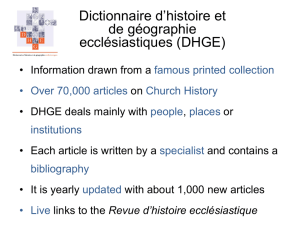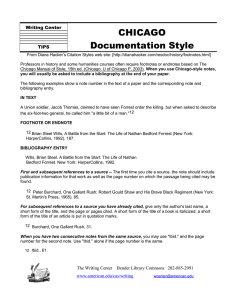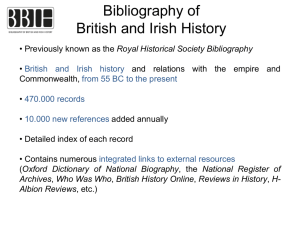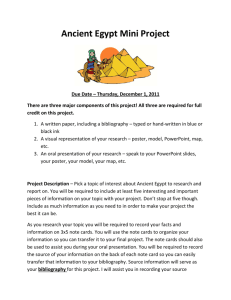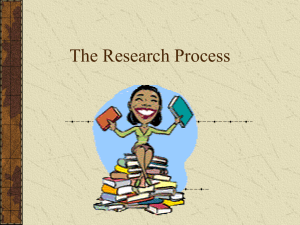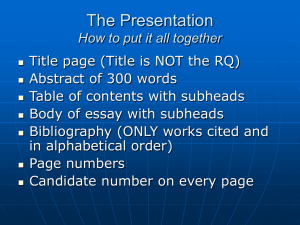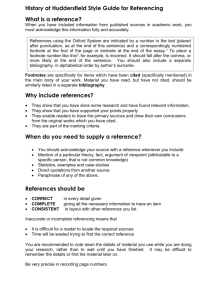Bibliography Guidelines
advertisement
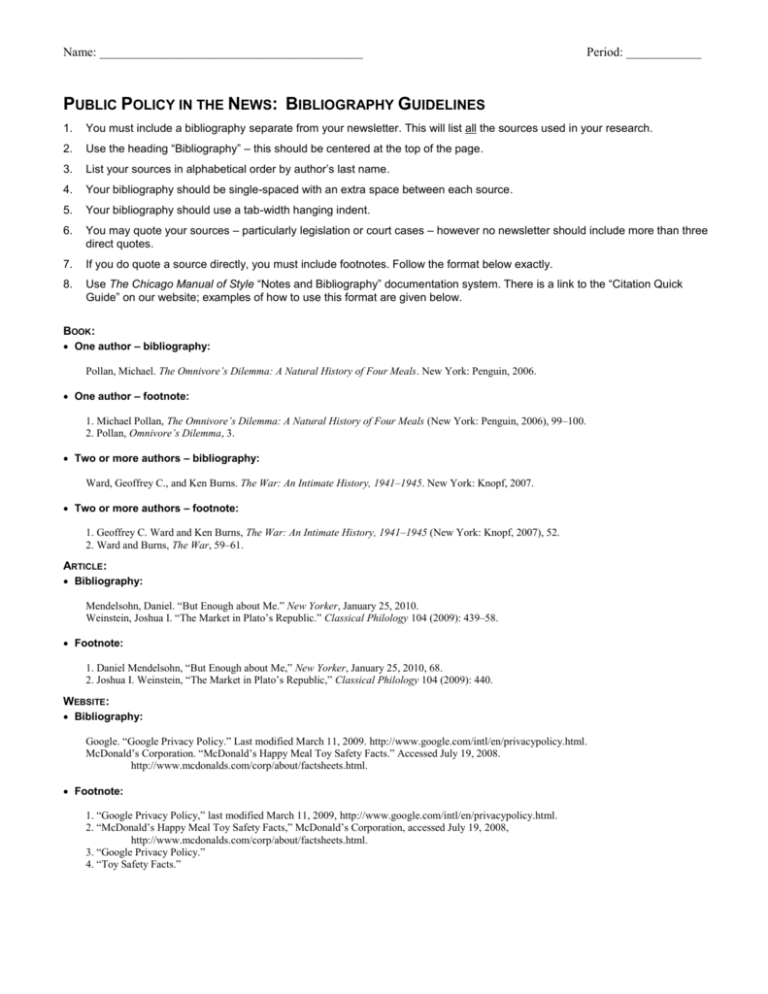
Name: __________________________________________ Period: ____________ PUBLIC POLICY IN THE NEWS: BIBLIOGRAPHY GUIDELINES 1. You must include a bibliography separate from your newsletter. This will list all the sources used in your research. 2. Use the heading “Bibliography” – this should be centered at the top of the page. 3. List your sources in alphabetical order by author’s last name. 4. Your bibliography should be single-spaced with an extra space between each source. 5. Your bibliography should use a tab-width hanging indent. 6. You may quote your sources – particularly legislation or court cases – however no newsletter should include more than three direct quotes. 7. If you do quote a source directly, you must include footnotes. Follow the format below exactly. 8. Use The Chicago Manual of Style “Notes and Bibliography” documentation system. There is a link to the “Citation Quick Guide” on our website; examples of how to use this format are given below. BOOK: One author – bibliography: Pollan, Michael. The Omnivore’s Dilemma: A Natural History of Four Meals. New York: Penguin, 2006. One author – footnote: 1. Michael Pollan, The Omnivore’s Dilemma: A Natural History of Four Meals (New York: Penguin, 2006), 99–100. 2. Pollan, Omnivore’s Dilemma, 3. Two or more authors – bibliography: Ward, Geoffrey C., and Ken Burns. The War: An Intimate History, 1941–1945. New York: Knopf, 2007. Two or more authors – footnote: 1. Geoffrey C. Ward and Ken Burns, The War: An Intimate History, 1941–1945 (New York: Knopf, 2007), 52. 2. Ward and Burns, The War, 59–61. ARTICLE: Bibliography: Mendelsohn, Daniel. “But Enough about Me.” New Yorker, January 25, 2010. Weinstein, Joshua I. “The Market in Plato’s Republic.” Classical Philology 104 (2009): 439–58. Footnote: 1. Daniel Mendelsohn, “But Enough about Me,” New Yorker, January 25, 2010, 68. 2. Joshua I. Weinstein, “The Market in Plato’s Republic,” Classical Philology 104 (2009): 440. WEBSITE: Bibliography: Google. “Google Privacy Policy.” Last modified March 11, 2009. http://www.google.com/intl/en/privacypolicy.html. McDonald’s Corporation. “McDonald’s Happy Meal Toy Safety Facts.” Accessed July 19, 2008. http://www.mcdonalds.com/corp/about/factsheets.html. Footnote: 1. “Google Privacy Policy,” last modified March 11, 2009, http://www.google.com/intl/en/privacypolicy.html. 2. “McDonald’s Happy Meal Toy Safety Facts,” McDonald’s Corporation, accessed July 19, 2008, http://www.mcdonalds.com/corp/about/factsheets.html. 3. “Google Privacy Policy.” 4. “Toy Safety Facts.” Bibliography Ashanti McFarlane, Nicole. “Digital Memory and Narrative through ‘African American Rhetoric[s] 2.0.’” Last modified March 28, 2012. http://enculturation.gmu.edu/digital-memory. Berlin, Ira. Many Thousands Gone: The First Two Centuries of Slavery in North America. Cambridge, MA: The Belknap Press of Harvard University Press, 1998. Douglass, Frederick. “The Church and Prejudice: Speech Delivered at the Plymouth County Anti-Slavery Society, November 4, 1841.” Accessed May 26, 2015. http://www.frederickdouglass.org/speeches/index.html. Foner, Eric. Reconstruction: America’s Unfinished Revolution, 1863-1877. New York: Harper & Row Publishers, 1988. Hope Franklin, John. Mirror to America: The Autobiography of John Hope Franklin. New York: Farrar, Straus and Giroux, 2005. Lincoln, C. Eric and Lawrence H. Mamiya. The Black Church in the African American Experience. Durham, NC: Duke University Press, 1995. Wilson, Douglas L. Lincoln’s Sword: The Presidency and the Power of Words. New York: Vintage Books, 2006.


